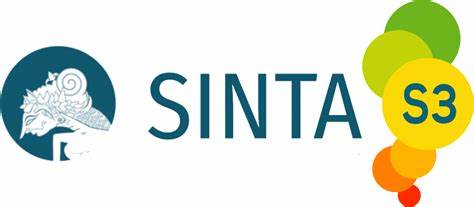MOTIVATIONAL FACTORS IN INDONESIAN SECONDARY EFL TEACHERS’ ONLINE CPD PARTICIPATION
Abstract
Motivation plays a critical role in driving teachers to engage in continuous professional development (CPD), influenced by a combination of intrinsic and extrinsic factors alongside contextual challenges. This study investigates the motivational factors shaping Indonesian secondary EFL English teachers’ participation in the Pengembangan Kompetensi Guru Bahasa Inggris (PKGBI) program, an online CPD initiative organized by the Ministry of Education. Employing a qualitative case study design, data were collected through an online questionnaire consisting of Likert-scale and open-ended items. Findings reveal that both intrinsic (e.g., self-improvement, teaching competence) and extrinsic motivation (e.g., institutional support, career advancement) strongly influence participation. However, significant contextual barriers, such as unequal access to technology, inadequate infrastructure, and time constrains continue to hinder participation, particularly among rural teachers. The study suggests the need for smaller, context-sensitive CPD programs tailored to local conditions. By leveraging motivational factors and addressing participation barriers, such programs can enhance teacher engagement and ultimately contribute to better educational outcomes.
References
Acar, S. E., & Erozan, F. (2024). Understanding English language teachers’ (de)motivation toward continuing professional development through psychological contract and work attitude. SAGE Open, April–June 2024, 1–14. https://doi.org/10.1177/21582440241242555
Bellibaş, M. Ş., Gümüş, S., & Chen, J. (2024). The impact of distributed leadership on teacher commitment: The mediation role of teacher workload stress and teacher well‐being. British Educational Research Journal, 50(2), 814-836. https://doi.org/10.1002/berj.3944
Bøhn, H., & Dysthe, O. (2021). Teachers' professional development and the role of mentoring. In Teacher learning and professional development (pp. 123–140). Springer.
Braun, V., & Clarke, V. (2006). Using thematic analysis in psychology. Qualitative research in psychology, 3(2), 77-101. https://doi.org/10.1191/1478088706qp063oa
Cohen, L., Manion, L., & Morrison, K. (2018). Research methods in education (8th ed.). Routledge.
Creswell, J. W. (2013). Qualitative inquiry and research design: Choosing among five approaches (3rd ed.). Sage.
Creswell, J. W., & Creswell, J. D. (2018). Research design: qualitative, quantitative, and mixed methods approaches (5th ed.).Sage Publications.
Creswell, J. W., & Plano Clark, V. L. (2018). Designing and conducting mixed methods research (3rd ed.). SAGE Publications.
Deci, E. L. (1975). The intrinsic motivation of behavior. In Intrinsic motivation (pp. 93-125). Boston, MA: Springer US.
Deci, E. L., & Ryan, R. M. (1985). Intrinsic Motivation and Self-Determination in Human Behavior. New York: Plenum Press.http://dx.doi.org/10.1007/978-1-4899-2271-7
EF Education First. (2024). EF English Proficiency Index 2024: Rankings and insights. Retrieved from https://www.ef.com/epi/
Fandino, F. G. E., Muñoz, L. D., & Velandia, A. J. S. (2019). Motivation and E-Learning English as a foreign language: A qualitative study. Heliyon, 5(9). https://doi.org/10.1016/j.heliyon.2019.e02394
Febriani, S., Sesmiarni, Z., & Akhyar, M. (2024). Implementasi Bimbingan Teknis Kurikulum Merdeka dalam Meningkatkan Kompetensi Guru Bidang Studi Agama di MIN Bukittinggi. Idarah Tarbawiyah: Journal of Management in Islamic Education, 5(1), 113-122.
Gonzaga, E. B. (2024). Opportunities, Teachers’ Attitude and Engagement in Continuing Professional Development (CPD) Activities. International Journal of Research – GRAN-THAALAYAH, 12(4), 53–78. https://doi.org/10.29121/granthaalayah.v12.i4.2024.5598
Guskey, T. R. (2002). Professional development and teacher change. Teachers and teaching, 8(3), 381-391. https://doi.org/10.1080/135406002100000512
Herzberg, F. (1966). Work and the nature of man. World Publishing Company.
Jud, J., Karlen, Y., & Hirt, C. N. (2024). Linking teachers’ and students’ motivation for self-regulated learning: is there a signal and how is it transmitted?. Metacognition and Learning, 19(3), 939-965.
Kaiyom, S. A., Rahman, R. A., & Mustaffa, W. S. W. (2021). The effect of workload, supervisor support and co-workers support on work engagement among teachers. International Journal of Academic Research in Business and Social Sciences, 11(8), 1633-1647. https://doi.org/10.6007/ijarbss/v11-i8/10878
Kanwal, A., Rafiq, S., & Afzal, A. (2023). Impact of Workload on Teachers'efficiency And Their Students'academic Achievement At The University Level. Gomal University Journal of Research, 39(2), 131-146. https://doi.org/10.51380/gujr-39-02-02
Lee, Y. S. (2024). Qualitative and mixed methods. In Translational orthopedics (pp. 229-232). Academic Press.
Mekie, M. E., & Gezahegn, G. (2023). EFL teachers' continuous professional development: Reflections and target needs. Journal of Pedagogical Sociology and Psychology, 5(3), 247-262.https://doi.org/10.33902/jpsp.202320247
Miles, M. B., Huberman, A. M., & Saldaña, J. (2014). Qualitative data analysis: A methods sourcebook (3rd ed.). Sage.
Özen, E., & Karaca, N. (2021). Investigating learner motivation in online education in terms of self-efficacy and self-regulation. Journal of Educational Technology & Online Learning, 4(4), 745–758. https://doi.org/10.31681/jetol.1016530
Rahman, B., Abdurrahman, A., Kadaryanto, B., & Rusminto, N. E. (2015). Teacher-based scaffolding as a teacher professional development program in Indonesia. Australian Journal of Teacher Education (Online), 40(11), 67-78. https://doi.org/10.14221/ajte.2015v40n11.4
Rasmitadila, R., Aliyyah, R. R., Rachmadtullah, R., Samsudin, A., Syaodih, E., Nurtanto, M., & Tambunan, A. R. S. (2020). The perceptions of primary school teachers of online learning during the COVID-19 pandemic period. Journal of Ethnic and Cultural Studies, 7(2), 90-109. https://doi.org/10.29333/ejecs/388
Ryan, R. M., & Deci, E. L. (2020). Intrinsic and extrinsic motivation from a self-determination theory perspective: Definitions, theory, practices, and future directions. Contemporary Educational Psychology, 61, 101860. https://doi.org/10.1016/j.cedpsych.2020.101860
Tarigan, K. E., & Stevani, M. (2021). The impact of covid-19 on online learning in K12 Indonesian schools: MACRO, Meso, and micro levels. International Journal of Arts and Humanities Studies, 1(1), 23.https://doi.org/10.32996/ijahs.2021.1.1.4
Vallerand, R. J., & Ratelle, C. F. (2002). Intrinsic and extrinsic motivation: A hierarchical model. In E. L. Deci & R. M. Ryan (Eds.), Handbook of self-determination research (pp. 37–63). Rochester: University of Rochester Press.
Vagias, W. M. (2006). Likert-type scale response anchors. clemson international institute for tourism. & Research Development, Department of Parks, Recreation and Tourism Management, Clemson University, 4(5).
Vansteenkiste, M., Aelterman, N., De Muynck, G.-J., Haerens, L., Patall, E., & Reeve, J. (2018). Fostering personal meaning and self-relevance: A self-determination theory perspective on internalization. The Journal of Experimental Education, 86(1), 30–49. https://doi.org/10.1080/00220973.2017.1381067
Tamášová, V., Lobotková, A., & Marks, I. (2024). Motivation of teachers and students as part of formative education. AD ALTA: Journal of Interdisciplinary Research, 14(1), 252–260. https://doi.org/10.33543/j.1401.252260
Yang, J. (2021). Understanding and enhancing Chinese TEFL teachers’ motivation for continuing professional development through the lens of self-determination theory. Frontiers in psychology, 12, 768320. https://doi.org/10.3389/fpsyg.2021.768320
Yin, R. K. (2018). Case study research and applications: Design and methods (6th ed.). Sage.
Downloads
Published
Issue
Section
License

This work is licensed under a Creative Commons Attribution-ShareAlike 4.0 International License.
The author is responsible for acquiring the permission(s) to reproduce any copyrighted figures, tables, data, or text that are being used in the submitted paper. Authors should note that text quotations of more than 250 words from a published or copyrighted work will require grant of permission from the original publisher to reprint. The written permission letter(s) must be submitted together with the manuscript.




